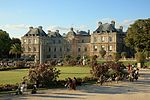User:NemesisIII/sandbox
Paris Ouest (West Paris) is an expression referring to the wealthiest and most prestigious residential area of France.
Located in the central and western part of Paris, it roughly follows Paris' Voie Royale (Royal Way) or Axe historique (historical axis): a line of monuments, buildings and thoroughfares that extends from the former
Paris Ouest has long been known as French high society's favorite place of residence, comparable to
The cultural, social and economic influence
History


In 1612, Queen
By the 17th century, French
The district became so fashionable within the French
In the 18th century, alongside the rising attraction of exclusive Faubourg Saint-Germain, the
During the 19th century, Paris became socially divided between an eastern
By the end of the 19th century, the new French high society, made of wealthy bourgeois and old nobles exclusively lived in Western Paris and the high-profile social life was deeply rooted there, as Marcel Proust described.[6] A state of things that has not changed much, according to sociologists Michel and Monique Pincon-Charlot,[7][8][9][10] the role of a Paris Ouest address and education is still extremely prominent to be part of the French elite.
Geography
Paris Ouest is made of four central and western Parisian arrondissements: the 6th, the 7th, the 8th and the 16th; and of the city of Neuilly-sur-Seine, which is immediately adjacent to the 16th.
Paris Ouest covers a land area of 21.7 km2 [11] or 30,66 km2.[12]
Demography
As of the 1999 census, 363.445 people were living in Paris Ouest:
| District | Year | Population | Density (inh. per km²) | |
|---|---|---|---|---|
| 6th arrondissement | 1999 | 44,919 | 20,854 | |
| 6th arrondissement | 2005 (est) | 45,200 | 20,984 | |
| 7th arrondissement | 1999 | 56,985 | 13,940 | |
| 7th arrondissement | 2005 (est) | 55,400 | 13,552 | |
| 8th arrondissement | 1999 | 39,314 | 10,130 | |
| 8th arrondissement | 2005 (est) | 38,700 | 9,972 | |
| 16th arrondissement | 1999 | 161,773 | 20,619 | |
| 16th arrondissement | 2005 (est) | 149,500 | 19,054 |
Sociology
Not only is Paris Ouest as a whole the wealthiest area in France, but the five districts that make it up, individually, rank at the top of France's highest income districts:
Among cities of over 50,000 inhabitants, Neuilly-sur-Seine, the western suburb immediately continuing Paris Ouest, is the wealthiest city in France, with an average household income of €62,646, and 20% earning more than €8,000 per month.[13] But within Paris, the four Western Paris'arrondissements surpass wealthy Neuilly-sur-Seine in household income: the 6th, the 7th, the 8th and the 16th ; the 8th "arrondissement" being the richest district in France (the others three following it closely as 3rd, 2nd and 4th richest ones).
When considering Paris Ouest as a whole, the average household income is close to €8,000 per month, which makes it one of the wealthiest areas in the world (slightly higher ranked than Teton County, Wyoming, the wealthiest U.S. county for household income, according to a 2009 governmental census[14]). Paris Ouest has also more people paying the solidarity tax on wealth (people who own more than €700.000 in assets, deducted of all debt) than anywhere else with around 60,000 declarers, a little more than 16% of its population.
Moreover, one-third of the French citizens whose fortune is at least €50 million live in the area (around 175 families),[15] and 8 out of the 10 richest French billionaires (and 70% of the 50 wealthiest French) live there as well, including the wealthiest European, LVMH owner and CEO Bernard Arnault (living in the 7th arrondissement), and the world's richest woman, L'Oréal heiress Liliane Bettencourt (living in Neuilly-sur-Seine).
That extreme concentration of wealth and power has led to a unique case of
Real estate
As a high society residential area, Paris Ouest has the most expensive real estates market in Paris and features some of the most expensive
References
- ^ [1] eyes of an American-born on one of the district of the area: the exclusive 16th arrondissement
- ^ For instance, Paris is the world's fashion design capital thanks to Paris Ouest's customers who historically make it up
- ^ Sociologists Michel and Monique Pinçon-Charlot's works highlight that trend
- Hotels particuliersin French
- Balzacexplains the very specific Faubourg's aristocratic way of life in his novel La Duchesse de Langeais
- ^ Part of Marcel Proust novel In search of lost Time describes the habits of French high society in the late 19th and early 20th
- ^ Les Ghettos du Gotha : comment la bourgeoisie défend ses espaces, Payot, Paris, 2009
- ^ Monique Pinçon-Charlot, Michel Pinçon, Sociologie de Paris, La Découverte, 2004
- ^ Monique Pinçon-Charlot, Michel Pinçon, Voyage en grande bourgeoisie, PUF, 1997, 2002, 2005
- ^ Monique Pinçon-Charlot, Michel Pinçon, Sociologie de la bourgeoisie, La Découverte, coll. « Repères » 2000, 2003
- ^ excluding the Bois de Boulogne
- ^ including the Bois de Boulogne
- ^ http://www.salairemoyen.com/revenus.php?Commune=92051&Ville=92200+-+NEUILLY+SUR+SEINE
- ^ Census 2000 Demographic Profiles
- ^ [2] list of weathiest French by localizations
- ^ See Piçon-Charlot's books listed above
- Vincent Bollore, Arnaud Lagardère, Dominique Desseigne and Alain Afflelou and famous singers Mylène Farmer and Sylvie Vartan
[[Category:Geography of Paris]


